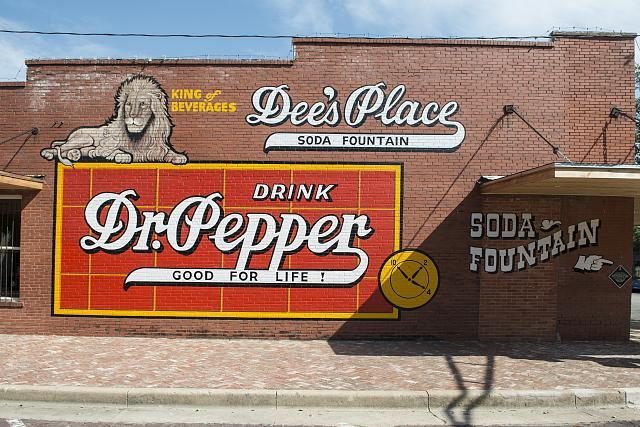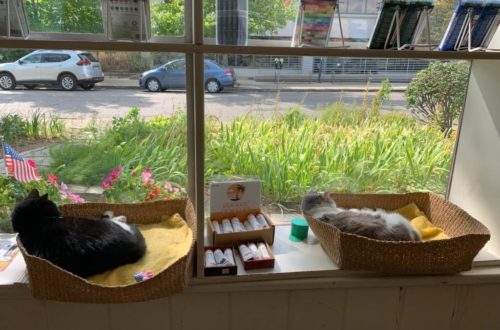The historical trade of sign-painting and a recent comeback that has talented sign-painters transforming the store fronts of cities and towns all over the country calls for a three part feature! Read on for Venerable Vintages, our monthly feature that examines the art supply industry through an historical lens; then check out our Artist Feature exploring the sign-painting work of Christian Shaknaitis of Brush and Pounce. Top off your sign-painting education with in store practices that incorporate sign-painting and boost your business.
Sign-painting is an ancient trade that dates back as early as 300 B.C. Merchants, pub owners, innkeepers and other business people have always needed to communicate what they are selling and why the passersby should take pause and step inside. Fast forward to the early 1900s where every store needed a quality sign painter and everyday, working class people with a knack for color, design and mechanics shaped city streets. The style was often specific to the culture of the place and dependent on the personality of the sign painter. Signs were “traditionally manufactured by resident village or city painter who had rarely been exposed to formal printing or compositional training…uninhibited with regard to the “correctness” of period type styles” (1). The result? Character, quality and culture.

Sign-painting includes building-sized messages, billboards, store fronts, windows, doors and menus. Remnants of the early sign-painting industry are known as ghost signs, old advertisements that are either left up out of apathy or nostalgia.

In an overview of sign-painting as a facet of art history, design historian Arden Stern eloquently identifies sign-painting as embedded in the fabric of our culture:
More than merely imitating printed text, skilled sign painters could push the limits of letterforms. Their ability to alter the sizes, shapes, color, and arrangement of words and images with the stroke of a brush made it possible to quickly produce an extensive, eloquent variety of compositions for their clients. Sign painters continue to blur the boundary between letters and pictures, often transforming even the simplest text into a sophisticated array of symbols that speak to different viewers. Even something as simple as a color scheme can alter the meaning of a sign: national flags, religious iconography, and personal taste might all find their way into a single group of letters on a neighborhood storefront. (7)
Over time there have been debates as to whether sign painting is a trade or an art. People within the community historically prefer the term mechanic. The act of sign-painting is extremely technical: ensuring that a design works for the space, getting the right equipment, adjusting the plan and strategy depending on the condition of the wall, inclement weather or tight timelines. They are also, in some ways, salespeople – the original one-man (historically, yes, man) marketing agency. They need to make the words stand out, grab attention, draw a customer in. In order to build their own business and get gigs, they need palpable results. And finally, the art and design aspect: the lettering, embellishments and stylized forms that are so essential to typographic design and hand-lettering.
Sign Painters, a 2014 documentary by Faythe Levine and Sam Macon explores the ebb and flow of sign-painting over the past thirty years:
Sign-painting was essentially an invisible industry in plain sight for a greater part of the 20th century until in the 1980s, when the vinyl plotter slowly infiltrated and nearly managed to make hand painted signs obsolete: “the resulting proliferation of computer-designed, die-cut vinyl lettering and inkjet printers has ushered a creeping sameness into our landscape” (2). Cheaply made and perfectly cut letters that withstood weather were in high demand and businesses and sign-painters alike began to use the convenient yet sterile vinyl cutter. While the industry had robust beginnings, when every business needed a quality sign painter, it encountered somewhat of a hibernation period during this time.
Now, sign-painting is experiencing a renaissance – a comeback, if you will.
We are seeing a renewed societal appreciation for handmade goods and “buying local.” (CITE) A hand-painted sign is a one-of-a-kind invitation that speaks volumes about the establishment, the people behind it and the products inside. A hand-painted sign invokes a personal touch and earnest invitation. Signage is “more than visual objects — [it can] evoke memories of precious moments past, and of fascinating, faraway places” (1).
This resurgence is made visible by social media; sign painters publicize their process, business owners document their new signage and the revival is being chronicled in real time. Read on to learn more about sign-painters like Christain Shaknaitis who are revitalizing city streets and small businesses.
References
- Signs of the Times, Klaus F. Schmidt, Graphis U.S., Inc., 1996.
- Sign Painters, Documentary by Faythe Levine and Sam Macon, Produced by Radar Studios. 2014
- What’s Old Is New: Traditional Sign Painting Is In Demand Again, Bob Studebaker. 90.5 WESA, Pittsburgh’s NPR Station May 28, 2018.
- A Brief History on Sign Painting, Jennifer Konanz. Konanz & Co, February 8 2017.
- Episode 74: Hand-Painted Signs. 99% Invisible, Produced by Sean Real. March 8 2013.
- Behind the Sign, Episode 1. Cleveland SGS. Oct 30, 2014.
- The Street Museum: Sign Painting as Art and History. Arden Stern, KCET. Public Media Group of Southern California, September 11 2012.






